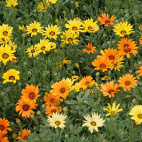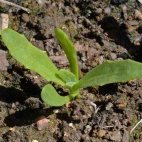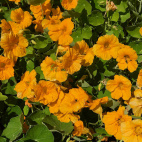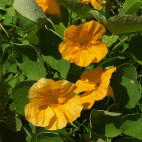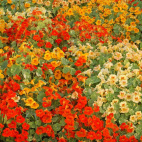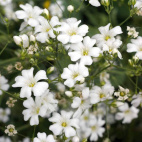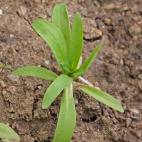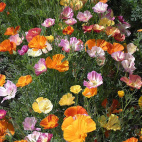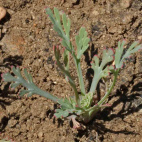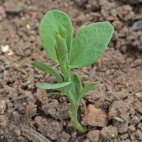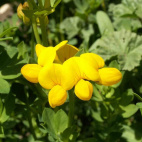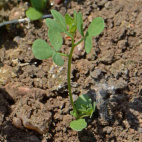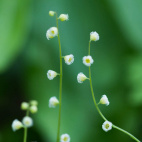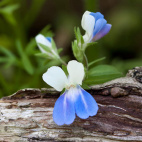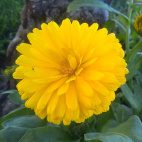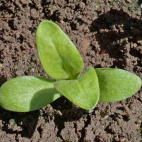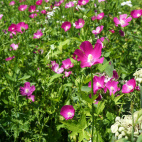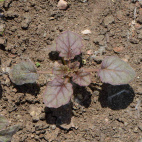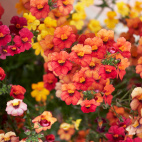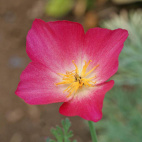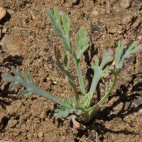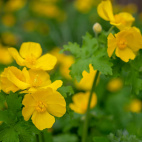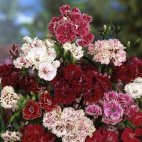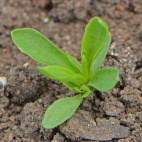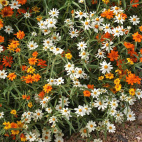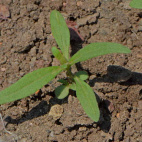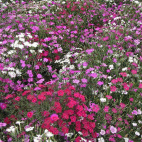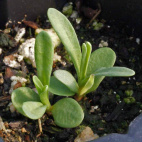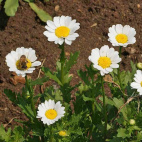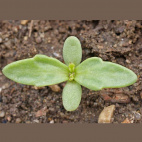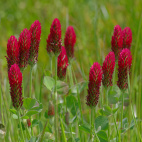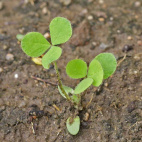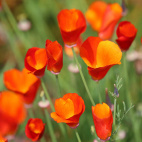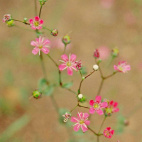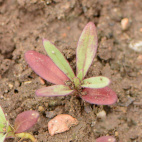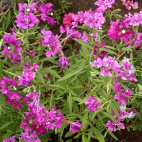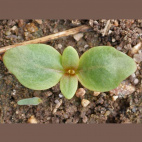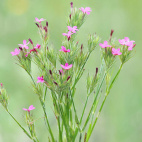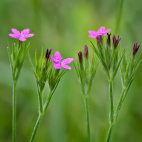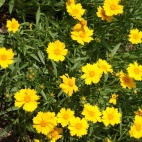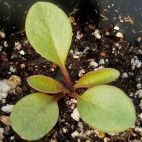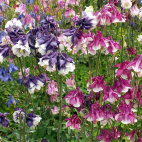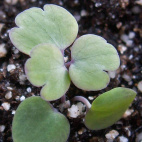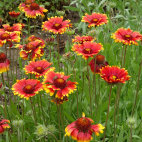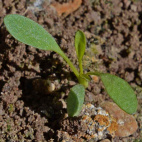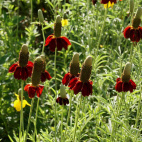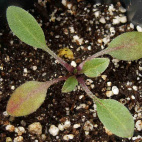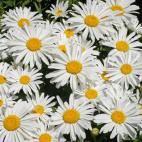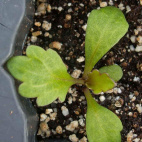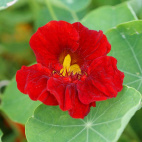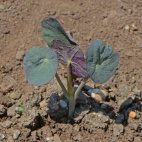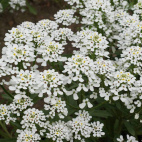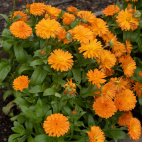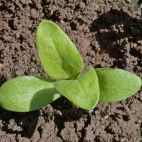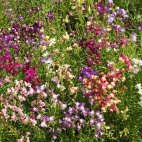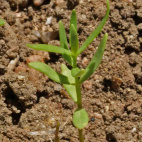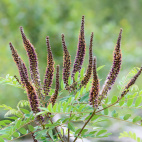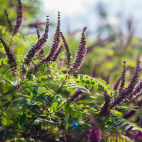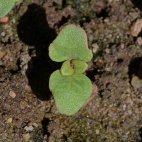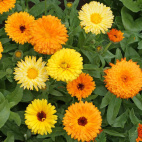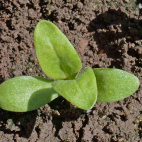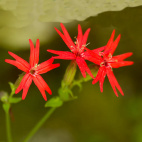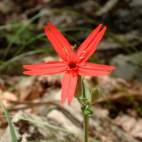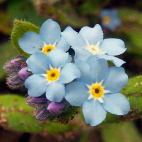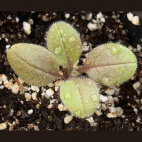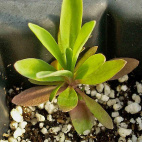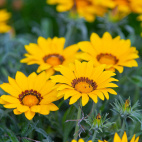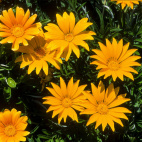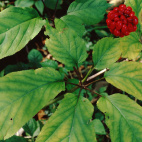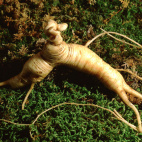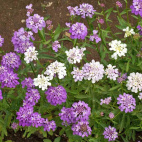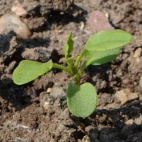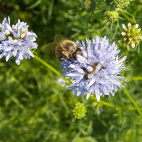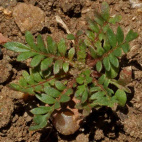Color
Availability
USDA Zone
Region
Type
Duration
Season
Germination
Soil
Sunlight
Height
Use
Narrow Your Search
Color
Availability
USDA Zone
Region
Type
Duration
Season
Germination
Soil
Sunlight
Height
Use
Wildflower Seeds - Southeast Region
-
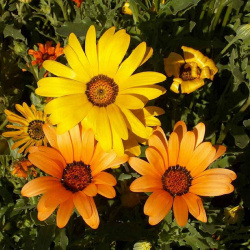 On Sale!
African Daisy Seeds
Dimorphotheca sinuata
These orange and yellow Daisies come from the wilds of Africa but will bring cheer and sunshine wherever they are planted. Always facing the sun, the bright blossoms close at sunset and in cloudy weather.Quick View$3.48 Pkt - $8.93 / Oz
On Sale!
African Daisy Seeds
Dimorphotheca sinuata
These orange and yellow Daisies come from the wilds of Africa but will bring cheer and sunshine wherever they are planted. Always facing the sun, the bright blossoms close at sunset and in cloudy weather.Quick View$3.48 Pkt - $8.93 / Oz -
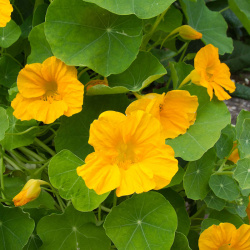 Out Of Stock
Alaska Gold Nasturtium Seeds
Tropaeolum nanum
Go for the gold with these rich yellow blooms, scattered among lovely variegated foliage. This easy-to-grow, compact annual also performs well as a container plant.Quick View$3.48 Pkt - $6.84 / Oz
Out Of Stock
Alaska Gold Nasturtium Seeds
Tropaeolum nanum
Go for the gold with these rich yellow blooms, scattered among lovely variegated foliage. This easy-to-grow, compact annual also performs well as a container plant.Quick View$3.48 Pkt - $6.84 / Oz -
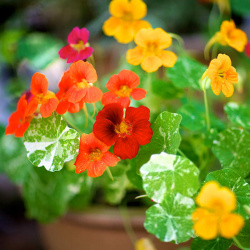 Alaska Nasturtium Seed Mix
Tropaeolum nanum
A dwarf variety, this mix comes in lovely shades of gold, orange, red, and yellow. This annual also has variegated leaves and is easy to grow, making it easy to have a beautiful flower bed with minimal effort.Quick View$3.48 Pkt - $6.84 / Oz
Alaska Nasturtium Seed Mix
Tropaeolum nanum
A dwarf variety, this mix comes in lovely shades of gold, orange, red, and yellow. This annual also has variegated leaves and is easy to grow, making it easy to have a beautiful flower bed with minimal effort.Quick View$3.48 Pkt - $6.84 / Oz -
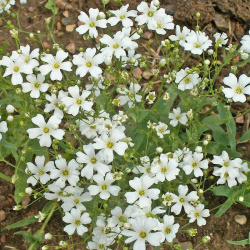 On Sale!
Annual Baby's Breath Seeds
Gypsophila elegans
Delicate, white sprays create a vision of loveliness for any occasion. This easy-to-grow annual grows quickly, and is popular for floral bouquets, but looks great in the garden too.Quick View$2.98 Pkt - $5.96 / Oz
On Sale!
Annual Baby's Breath Seeds
Gypsophila elegans
Delicate, white sprays create a vision of loveliness for any occasion. This easy-to-grow annual grows quickly, and is popular for floral bouquets, but looks great in the garden too.Quick View$2.98 Pkt - $5.96 / Oz -
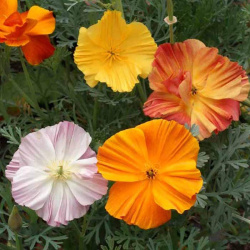 On Sale!
Ballerina California Poppy Seed Mix
Eschscholzia californica
Beautiful shades of red, pink, and gold will dazzle the eye with this popular California Poppy mix. The silky, cup-shaped flowers form on slender stems just like the common Orange California Poppy, but this shows off with many more colors.Quick Viewx
On Sale!
Ballerina California Poppy Seed Mix
Eschscholzia californica
Beautiful shades of red, pink, and gold will dazzle the eye with this popular California Poppy mix. The silky, cup-shaped flowers form on slender stems just like the common Orange California Poppy, but this shows off with many more colors.Quick ViewxBallerina California Poppy Seed Mix
Eschscholzia californica
Beautiful shades of red, pink, and gold will dazzle the eye with this popular California Poppy mix. The silky, cup-shaped flowers form on slender stems just like the common Orange California Poppy, but this shows off with many more colors.
$3.48 Pkt - $13.00 / Oz -
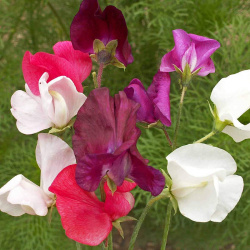 Bijou Sweet Pea Seed Mix
Lathyrus odoratus
This dwarf Sweet Pea variety produces masses of fragrant flowers on sturdy, bushy plants. Perfect for bouquets, this mix includes red, pink, purple, blue, and white. This annual is very easy to grow and is a must for those who love various aromas in their garden.Quick Viewx
Bijou Sweet Pea Seed Mix
Lathyrus odoratus
This dwarf Sweet Pea variety produces masses of fragrant flowers on sturdy, bushy plants. Perfect for bouquets, this mix includes red, pink, purple, blue, and white. This annual is very easy to grow and is a must for those who love various aromas in their garden.Quick ViewxBijou Sweet Pea Seed Mix
Lathyrus odoratus
This dwarf Sweet Pea variety produces masses of fragrant flowers on sturdy, bushy plants. Perfect for bouquets, this mix includes red, pink, purple, blue, and white. This annual is very easy to grow and is a must for those who love various aromas in their garden.
$3.75 Pkt - $9.35 / Oz -
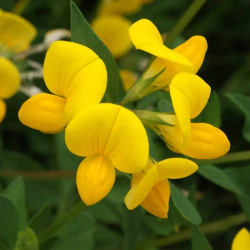 On Sale!
Bird's Foot Trefoil Seeds
Lotus corniculatus
This nitrogen-fixing legume is best known for its incredible adaptability to almost any soil type, which explains why it has naturalized across much of the US. This cheery yellow flower makes excellent forage for livestock and can be grown and harvested for hay. Care should be taken in where it is planted as it can become aggressive in ideal conditions.Quick Viewx
On Sale!
Bird's Foot Trefoil Seeds
Lotus corniculatus
This nitrogen-fixing legume is best known for its incredible adaptability to almost any soil type, which explains why it has naturalized across much of the US. This cheery yellow flower makes excellent forage for livestock and can be grown and harvested for hay. Care should be taken in where it is planted as it can become aggressive in ideal conditions.Quick ViewxBird's Foot Trefoil Seeds
Lotus corniculatus
This nitrogen-fixing legume is best known for its incredible adaptability to almost any soil type, which explains why it has naturalized across much of the US. This cheery yellow flower makes excellent forage for livestock and can be grown and harvested for hay. Care should be taken in where it is planted as it can become aggressive in ideal conditions.
$3.75 Pkt - $7.01 / Oz -
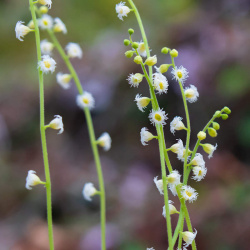 Store in the Fridge
Bishop's Cap Seeds
Mitella diphylla
Clinging to slender stems, these tiny, white flowers look like delicate lace. This native plant prefers moist, wooded areas, and is a pretty rare find in the wild. It is even more unusual in gardens because it takes some skill and patience to grow this wildflower.Quick Viewx
Store in the Fridge
Bishop's Cap Seeds
Mitella diphylla
Clinging to slender stems, these tiny, white flowers look like delicate lace. This native plant prefers moist, wooded areas, and is a pretty rare find in the wild. It is even more unusual in gardens because it takes some skill and patience to grow this wildflower.Quick ViewxBishop's Cap Seeds
Mitella diphylla
Clinging to slender stems, these tiny, white flowers look like delicate lace. This native plant prefers moist, wooded areas, and is a pretty rare find in the wild. It is even more unusual in gardens because it takes some skill and patience to grow this wildflower.
$3.96 Pkt - $320.00 / Oz -
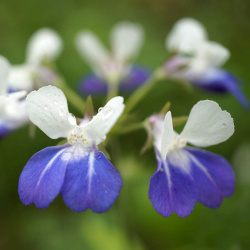 Out Of Stock
Blue Eyed Mary Seeds
Collinsia grandiflora
Expect compliments on this blue-eyed little beauty. The bright flower naturally grows in dry prairies, rocky areas, or at the border of woodlands, but seems quite at home in most average garden conditions as well.Quick Viewx
Out Of Stock
Blue Eyed Mary Seeds
Collinsia grandiflora
Expect compliments on this blue-eyed little beauty. The bright flower naturally grows in dry prairies, rocky areas, or at the border of woodlands, but seems quite at home in most average garden conditions as well.Quick ViewxBlue Eyed Mary Seeds
Collinsia grandiflora
Expect compliments on this blue-eyed little beauty. The bright flower naturally grows in dry prairies, rocky areas, or at the border of woodlands, but seems quite at home in most average garden conditions as well.
$3.48 Pkt - $10.19 / Oz -
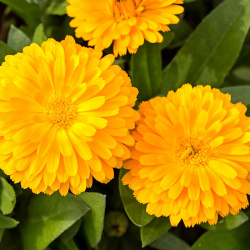 Out Of Stock
Bon Bon Yellow Calendula Seeds
Calendula officinalis
Varying from cream to bright yellow, these compact blooms provide color all season. The lovely Calendula aroma is also a natural mosquito repellant. The easy-to-grow annual is attractive as a cut flower or a garnish.Quick View$3.48 Pkt - $7.65 / Oz
Out Of Stock
Bon Bon Yellow Calendula Seeds
Calendula officinalis
Varying from cream to bright yellow, these compact blooms provide color all season. The lovely Calendula aroma is also a natural mosquito repellant. The easy-to-grow annual is attractive as a cut flower or a garnish.Quick View$3.48 Pkt - $7.65 / Oz -
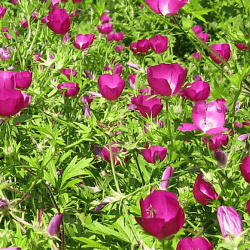 Bush's Poppy Mallow Seeds
Callirhoe bushii
Trailing habit and bright blossoms make this an eye-catching addition to rock gardens or rock walls. It also spreads to form a bushy native ground cover.Quick View$3.48 Pkt - $40.00 / Oz
Bush's Poppy Mallow Seeds
Callirhoe bushii
Trailing habit and bright blossoms make this an eye-catching addition to rock gardens or rock walls. It also spreads to form a bushy native ground cover.Quick View$3.48 Pkt - $40.00 / Oz -
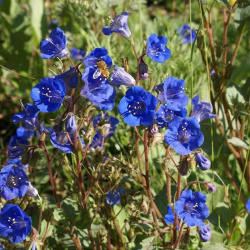 On Sale!
California Bluebell Seeds
Phacelia campanularia
This wildflower grows its intense blue bells in the wild deserts of California and Arizona. This tough little annual native now also colors gardens across the country, planted en masse, in rock gardens, or in even in containers. Bees are drawn to the wildflower as a source of nectar early in the growing season.Quick Viewx
On Sale!
California Bluebell Seeds
Phacelia campanularia
This wildflower grows its intense blue bells in the wild deserts of California and Arizona. This tough little annual native now also colors gardens across the country, planted en masse, in rock gardens, or in even in containers. Bees are drawn to the wildflower as a source of nectar early in the growing season.Quick ViewxCalifornia Bluebell Seeds
Phacelia campanularia
This wildflower grows its intense blue bells in the wild deserts of California and Arizona. This tough little annual native now also colors gardens across the country, planted en masse, in rock gardens, or in even in containers. Bees are drawn to the wildflower as a source of nectar early in the growing season.
$2.98 Pkt - $9.71 / Oz -
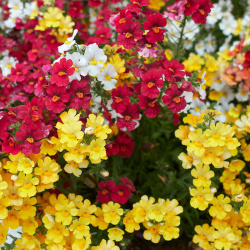 Out Of Stock
Cape Jewels Seeds
Nemesia strumosa
Plant a treasure trove in the backyard with these bright, pretty flowers. These pansy-like annuals originally grew around the Cape of South Africa, and are an excellent choice for massed plantings, hanging baskets, and borders.Quick Viewx
Out Of Stock
Cape Jewels Seeds
Nemesia strumosa
Plant a treasure trove in the backyard with these bright, pretty flowers. These pansy-like annuals originally grew around the Cape of South Africa, and are an excellent choice for massed plantings, hanging baskets, and borders.Quick ViewxCape Jewels Seeds
Nemesia strumosa
Plant a treasure trove in the backyard with these bright, pretty flowers. These pansy-like annuals originally grew around the Cape of South Africa, and are an excellent choice for massed plantings, hanging baskets, and borders.
$3.48 Pkt - $14.91 / Oz -
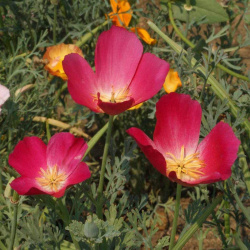 Carmine King California Poppy Seeds
Eschscholzia californica
A delicate rose pink with white centers, these blossoms are fit for royalty. This variety possesses the form and beauty of the Orange California Poppy, but just blooms in a different color.Quick View$2.98 Pkt - $9.54 / Oz
Carmine King California Poppy Seeds
Eschscholzia californica
A delicate rose pink with white centers, these blossoms are fit for royalty. This variety possesses the form and beauty of the Orange California Poppy, but just blooms in a different color.Quick View$2.98 Pkt - $9.54 / Oz -
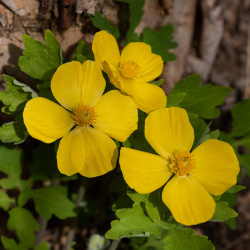 Store in the Fridge
Celandine Poppy Seeds
Stylophorum diphyllum
Also known as wood poppies, these brilliant yellow celandine poppies have it made in the shade. Sometimes challenging to grow from seed, this wildflower is best planted in the late summer or fall with freshly harvested seeds.Quick View$3.96 Pkt - $400.00 / Oz
Store in the Fridge
Celandine Poppy Seeds
Stylophorum diphyllum
Also known as wood poppies, these brilliant yellow celandine poppies have it made in the shade. Sometimes challenging to grow from seed, this wildflower is best planted in the late summer or fall with freshly harvested seeds.Quick View$3.96 Pkt - $400.00 / Oz -
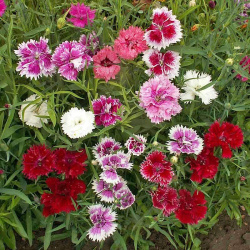 Chinese Pinks Seeds
Dianthus chinensis
Add a bit of exotic flair to the garden spot with these brilliant, fringed blossoms. This variety will flourish with little effort and will yield multitudes of exquisite little blooms.Quick Viewx
Chinese Pinks Seeds
Dianthus chinensis
Add a bit of exotic flair to the garden spot with these brilliant, fringed blossoms. This variety will flourish with little effort and will yield multitudes of exquisite little blooms.Quick ViewxChinese Pinks Seeds
Dianthus chinensis
Add a bit of exotic flair to the garden spot with these brilliant, fringed blossoms. This variety will flourish with little effort and will yield multitudes of exquisite little blooms.
$2.98 Pkt - $10.45 / Oz -
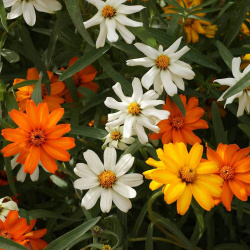 Classic Zinnia Seeds
Zinnia linearis
This time-honored Zinnia variety produces orange, yellow, and white blossoms on compact, bushy plants. These flowers are more like a daisy than many Zinnias, but they are still well-loved by the bees and butterflies.Quick View$3.48 Pkt - $32.00 / Oz
Classic Zinnia Seeds
Zinnia linearis
This time-honored Zinnia variety produces orange, yellow, and white blossoms on compact, bushy plants. These flowers are more like a daisy than many Zinnias, but they are still well-loved by the bees and butterflies.Quick View$3.48 Pkt - $32.00 / Oz -
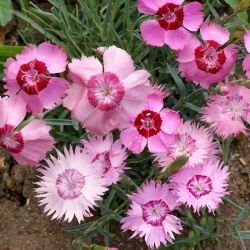 On Sale!
Cottage Pinks Seeds
Dianthus plumarius
Perfect for a cottage garden, these delicate blossoms bring sweet, old-fashioned charm. This perennial gives off a distinctive, clove-like scent, and is very easy to grow.Quick View$3.75 Pkt - $11.47 / Oz
On Sale!
Cottage Pinks Seeds
Dianthus plumarius
Perfect for a cottage garden, these delicate blossoms bring sweet, old-fashioned charm. This perennial gives off a distinctive, clove-like scent, and is very easy to grow.Quick View$3.75 Pkt - $11.47 / Oz -
 Creeping Daisy Seeds
Chrysanthemum paludosum
These sweet little daisies are a perfect choice for rock gardens, containers, window boxes, or as a ground cover. The low-growing Chrysanthemum paludosum is an annual but reseeds itself to produce plants the following year.Quick View$3.48 Pkt - $14.07 / Oz
Creeping Daisy Seeds
Chrysanthemum paludosum
These sweet little daisies are a perfect choice for rock gardens, containers, window boxes, or as a ground cover. The low-growing Chrysanthemum paludosum is an annual but reseeds itself to produce plants the following year.Quick View$3.48 Pkt - $14.07 / Oz -
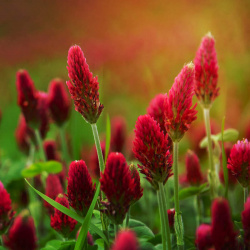 Crimson Clover Seeds
Trifolium incarnatum
Blooming in brilliant red, this popular annual clover adds plenty of color to pasture or meadow. This plant also provides excellent forage for grazing animals and nectar for foraging bees and other pollinators.Quick View$3.48 Pkt - $5.96 / Oz
Crimson Clover Seeds
Trifolium incarnatum
Blooming in brilliant red, this popular annual clover adds plenty of color to pasture or meadow. This plant also provides excellent forage for grazing animals and nectar for foraging bees and other pollinators.Quick View$3.48 Pkt - $5.96 / Oz -
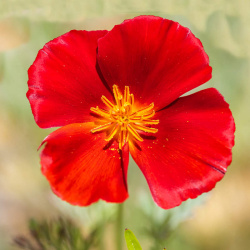 Out Of Stock
Dark Red California Poppy Seeds
Eschscholzia californica
This rare variety blooms in a rich, crimson hue. It is not always available, so check out Red Chief California Poppy if this variety is unavailable.Quick Viewx
Out Of Stock
Dark Red California Poppy Seeds
Eschscholzia californica
This rare variety blooms in a rich, crimson hue. It is not always available, so check out Red Chief California Poppy if this variety is unavailable.Quick ViewxDark Red California Poppy Seeds
Eschscholzia californica
This rare variety blooms in a rich, crimson hue. It is not always available, so check out Red Chief California Poppy if this variety is unavailable.
$3.48 Pkt - $8.93 / Oz -
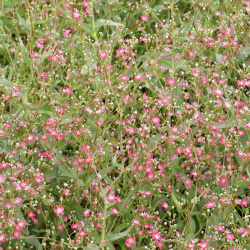 Deep Carmine Baby's Breath Seeds
Gypsophila elegans
Tiny crimson flowers, and feathery gray-green foliage gives a delicate, airy feel. This annual is perfect for floral arrangements and is very easy to grow in the home garden.Quick View$3.25 Pkt - $9.54 / Oz
Deep Carmine Baby's Breath Seeds
Gypsophila elegans
Tiny crimson flowers, and feathery gray-green foliage gives a delicate, airy feel. This annual is perfect for floral arrangements and is very easy to grow in the home garden.Quick View$3.25 Pkt - $9.54 / Oz -
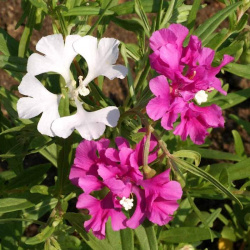 On Sale!
Deerhorn Clarkia Seeds
Clarkia pulchella
Delicate as fairies' wings, this variety showcases eye-catching pink blossoms. This annual wildflower is great for flower beds, borders, containers, rock gardens, and native plantings.Quick View$3.25 Pkt - $14.49 / Oz
On Sale!
Deerhorn Clarkia Seeds
Clarkia pulchella
Delicate as fairies' wings, this variety showcases eye-catching pink blossoms. This annual wildflower is great for flower beds, borders, containers, rock gardens, and native plantings.Quick View$3.25 Pkt - $14.49 / Oz -
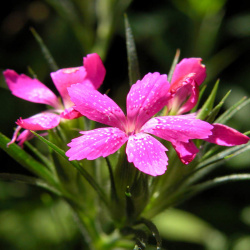 Deptford Pink Seeds
Dianthus armeria
This European native is closely related to the old-fashioned Sweet William. The lovely pink blossoms feature delicate fringed edging. It is an annual that is very easy to grow.Quick View$3.96 Pkt - $100.00 / Oz
Deptford Pink Seeds
Dianthus armeria
This European native is closely related to the old-fashioned Sweet William. The lovely pink blossoms feature delicate fringed edging. It is an annual that is very easy to grow.Quick View$3.96 Pkt - $100.00 / Oz -
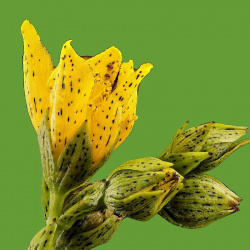 Dotted St John's Wort Seeds
Hypericum punctatum
Dotted St John's Wort is often grown for medicinal uses, but it does have pretty yellow blossoms as well. This perennial is a miniature and is very easy to grow in average garden conditions.Quick Viewx
Dotted St John's Wort Seeds
Hypericum punctatum
Dotted St John's Wort is often grown for medicinal uses, but it does have pretty yellow blossoms as well. This perennial is a miniature and is very easy to grow in average garden conditions.Quick ViewxDotted St John's Wort Seeds
Hypericum punctatum
Dotted St John's Wort is often grown for medicinal uses, but it does have pretty yellow blossoms as well. This perennial is a miniature and is very easy to grow in average garden conditions.
$3.75 Pkt - $160.00 / Oz -
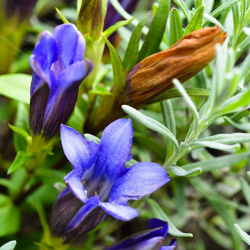 Out Of Stock
Downy Gentian Seeds
Gentiana puberulenta
Nearly identical to the traditional European gentian, this American native tolerates drought better than it's cousin. The deep violet blossoms spring up in prairies or rocky ground.Quick Viewx
Out Of Stock
Downy Gentian Seeds
Gentiana puberulenta
Nearly identical to the traditional European gentian, this American native tolerates drought better than it's cousin. The deep violet blossoms spring up in prairies or rocky ground.Quick ViewxDowny Gentian Seeds
Gentiana puberulenta
Nearly identical to the traditional European gentian, this American native tolerates drought better than it's cousin. The deep violet blossoms spring up in prairies or rocky ground.
$3.96 Pkt - $200.00 / Oz -
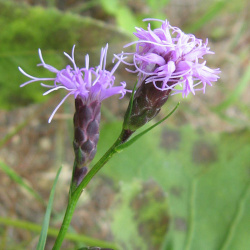 Dwarf Blazing Star Seeds
Liatris cylindracea
Reaching just one foot in height, this little native perennial has remarkable ability to attract butterflies, bees, and hummingbirds to your garden. Like most Liatris, it takes a few years for this little plant to become established, but it is quite long-lived.Quick Viewx
Dwarf Blazing Star Seeds
Liatris cylindracea
Reaching just one foot in height, this little native perennial has remarkable ability to attract butterflies, bees, and hummingbirds to your garden. Like most Liatris, it takes a few years for this little plant to become established, but it is quite long-lived.Quick ViewxDwarf Blazing Star Seeds
Liatris cylindracea
Reaching just one foot in height, this little native perennial has remarkable ability to attract butterflies, bees, and hummingbirds to your garden. Like most Liatris, it takes a few years for this little plant to become established, but it is quite long-lived.
$3.75 Pkt - $108.00 / Oz -
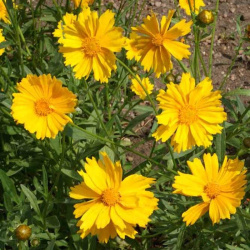 On Sale!
Dwarf Lance Leaved Coreopsis Seeds
Coreopsis lanceolata
These easy-to-grow wildflowers are a shorter member of the family that bloom late summer. A popular choice of beginning gardeners and master gardeners alike, who have limited space in their garden.Quick View$3.48 Pkt - $7.92 / Oz
On Sale!
Dwarf Lance Leaved Coreopsis Seeds
Coreopsis lanceolata
These easy-to-grow wildflowers are a shorter member of the family that bloom late summer. A popular choice of beginning gardeners and master gardeners alike, who have limited space in their garden.Quick View$3.48 Pkt - $7.92 / Oz -
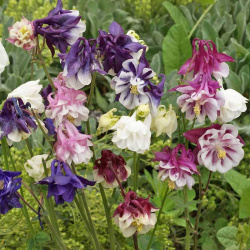 Dwarf Columbine Seed Mix
Aquilegia vulgaris
These delicate, nodding blossoms grow wild throughout much of northern Europe. This 16" dwarf variety produces a lovely mix of colors that will brighten any space!Quick View$3.48 Pkt - $12.65 / Oz
Dwarf Columbine Seed Mix
Aquilegia vulgaris
These delicate, nodding blossoms grow wild throughout much of northern Europe. This 16" dwarf variety produces a lovely mix of colors that will brighten any space!Quick View$3.48 Pkt - $12.65 / Oz -
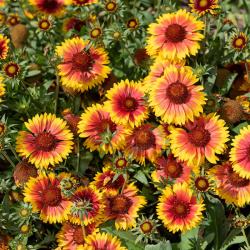 Out Of Stock
Dwarf Perennial Gaillardia Seeds
Gaillardia aristata
This showy golden flower is a petite version of the very popular Blanket Flower, and its short stature makes it ideal for small gardens or even container gardening. The easy-to-grow blooms provide color all season long.Quick Viewx
Out Of Stock
Dwarf Perennial Gaillardia Seeds
Gaillardia aristata
This showy golden flower is a petite version of the very popular Blanket Flower, and its short stature makes it ideal for small gardens or even container gardening. The easy-to-grow blooms provide color all season long.Quick ViewxDwarf Perennial Gaillardia Seeds
Gaillardia aristata
This showy golden flower is a petite version of the very popular Blanket Flower, and its short stature makes it ideal for small gardens or even container gardening. The easy-to-grow blooms provide color all season long.
$3.96 Pkt - $17.16 / Oz -
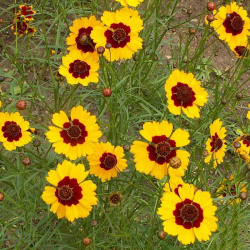 Dwarf Plains Coreopsis Seeds
Coreopsis tinctoria
This slender annual produces masses of yellow flowers with contrasting deep red centers. A popular choice of beginning gardeners because it is so easy to grow and produces a gratifying flower.Quick View$2.98 Pkt - $7.59 / Oz
Dwarf Plains Coreopsis Seeds
Coreopsis tinctoria
This slender annual produces masses of yellow flowers with contrasting deep red centers. A popular choice of beginning gardeners because it is so easy to grow and produces a gratifying flower.Quick View$2.98 Pkt - $7.59 / Oz -
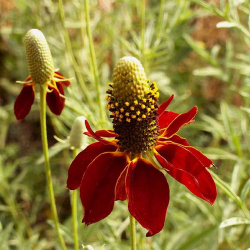 Out Of Stock
Dwarf Red Coneflower Seeds
Ratibida columnifera
This native dwarf wildflower bears a deep red flower beneath a long brown cone. This perennial does well in hot, dry areas, and is pretty easy to grow.Quick View$3.25 Pkt - $8.20 / Oz
Out Of Stock
Dwarf Red Coneflower Seeds
Ratibida columnifera
This native dwarf wildflower bears a deep red flower beneath a long brown cone. This perennial does well in hot, dry areas, and is pretty easy to grow.Quick View$3.25 Pkt - $8.20 / Oz -
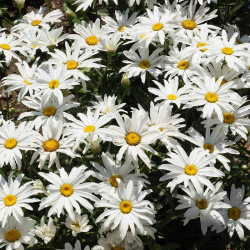 On Sale!
Dwarf Shasta Daisy Seeds
Chrysanthemum maximum
This daisy looks a lot like the Ox Eye Daisy, but it is not as invasive, and so is a better option in most cases. This delightful dwarf variety will bring charm all summer long.Quick View$3.48 Pkt - $14.91 / Oz
On Sale!
Dwarf Shasta Daisy Seeds
Chrysanthemum maximum
This daisy looks a lot like the Ox Eye Daisy, but it is not as invasive, and so is a better option in most cases. This delightful dwarf variety will bring charm all summer long.Quick View$3.48 Pkt - $14.91 / Oz -
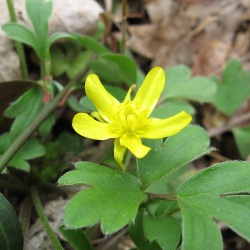 Store in the FridgeOut Of Stock
Early Buttercup Seeds
Ranunculus fascicularis
Bright as a button, these early bloomers are one of the first to welcome spring. Seeing these petite yellow flowers popping open is always a welcome sight after a long winter when everything looks dead. This little perennial is an ideal choice for rock gardens.Quick Viewx
Store in the FridgeOut Of Stock
Early Buttercup Seeds
Ranunculus fascicularis
Bright as a button, these early bloomers are one of the first to welcome spring. Seeing these petite yellow flowers popping open is always a welcome sight after a long winter when everything looks dead. This little perennial is an ideal choice for rock gardens.Quick ViewxEarly Buttercup Seeds
Ranunculus fascicularis
Bright as a button, these early bloomers are one of the first to welcome spring. Seeing these petite yellow flowers popping open is always a welcome sight after a long winter when everything looks dead. This little perennial is an ideal choice for rock gardens.
$3.96 Pkt - $160.00 / Oz -
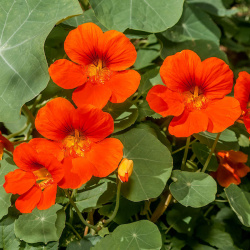 Empress of India Nasturtium Seeds
Tropaeolum nanum
A splendor to behold, these rich crimson flowers contrast with their blue-green foliage. This annual is compact and easy to grow, making it a great container plant.Quick View$3.48 Pkt - $6.84 / Oz
Empress of India Nasturtium Seeds
Tropaeolum nanum
A splendor to behold, these rich crimson flowers contrast with their blue-green foliage. This annual is compact and easy to grow, making it a great container plant.Quick View$3.48 Pkt - $6.84 / Oz -
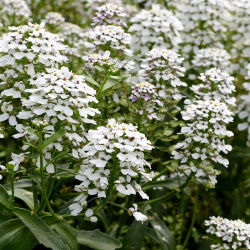 On Sale!
Empress Rocket Candytuft Seeds
Iberis amara
This easy carefree annual will be blooming in almost no time flat. The fragrant white flower clusters make beautiful bouquets, and add a sweet aroma to any garden.Quick View$3.48 Pkt - $7.92 / Oz
On Sale!
Empress Rocket Candytuft Seeds
Iberis amara
This easy carefree annual will be blooming in almost no time flat. The fragrant white flower clusters make beautiful bouquets, and add a sweet aroma to any garden.Quick View$3.48 Pkt - $7.92 / Oz -
 English Marigold Seeds
Calendula officinalis
A favorite around the world, this brilliant orange flower will brighten any garden. The sunny annual blooms all summer, and has a distinctive fragrance that naturally repels mosquitos.Quick View$3.48 Pkt - $7.09 / Oz
English Marigold Seeds
Calendula officinalis
A favorite around the world, this brilliant orange flower will brighten any garden. The sunny annual blooms all summer, and has a distinctive fragrance that naturally repels mosquitos.Quick View$3.48 Pkt - $7.09 / Oz -
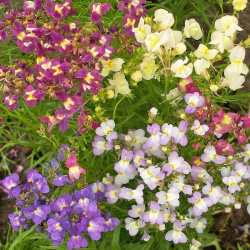 Fairy Bouquet Snapdragon Seed Mix
Linaria maroccana
Plant a fairytale garden with these dainty jewel-like beauties. This delightful annual is popular for containers or borders and makes an excellent cut flower as well. It is easy to grow and does not take up much space in the garden.Quick View$2.98 Pkt - $8.93 / Oz
Fairy Bouquet Snapdragon Seed Mix
Linaria maroccana
Plant a fairytale garden with these dainty jewel-like beauties. This delightful annual is popular for containers or borders and makes an excellent cut flower as well. It is easy to grow and does not take up much space in the garden.Quick View$2.98 Pkt - $8.93 / Oz -
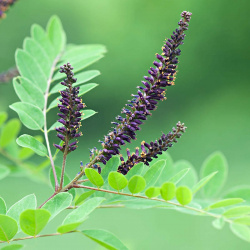 On Sale!
False Indigo Seeds
Amorpha fruticosa
Growing naturally in prairie meadows, False Indigo thrives across most of the United States. This native shrub also has attractive, sweet-scented foliage. Cannot ship to WA State.Quick View$3.48 Pkt - $14.49 / Oz
On Sale!
False Indigo Seeds
Amorpha fruticosa
Growing naturally in prairie meadows, False Indigo thrives across most of the United States. This native shrub also has attractive, sweet-scented foliage. Cannot ship to WA State.Quick View$3.48 Pkt - $14.49 / Oz -
 Farewell to Spring Seeds
Clarkia amoena
These satiny, cup-shaped flowers are a lovely herald of summer and are native to the west coast. This annual wildflower is excellent for flower beds, borders, containers, rock gardens, and native plantings.Quick View$2.98 Pkt - $8.46 / Oz
Farewell to Spring Seeds
Clarkia amoena
These satiny, cup-shaped flowers are a lovely herald of summer and are native to the west coast. This annual wildflower is excellent for flower beds, borders, containers, rock gardens, and native plantings.Quick View$2.98 Pkt - $8.46 / Oz -
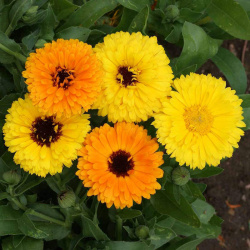 Fiesta Gitana Calendula Seed Mix
Calendula officinalis
A frost-hardy annual, this bushy clump-forming plant will flower all summer. The plants also give off a lovely Calendula fragrance that acts as a natural mosquito repellant. The easy-to-grow annual is attractive as a cut flower or a garnish.Quick View$3.48 Pkt - $7.27 / Oz
Fiesta Gitana Calendula Seed Mix
Calendula officinalis
A frost-hardy annual, this bushy clump-forming plant will flower all summer. The plants also give off a lovely Calendula fragrance that acts as a natural mosquito repellant. The easy-to-grow annual is attractive as a cut flower or a garnish.Quick View$3.48 Pkt - $7.27 / Oz -
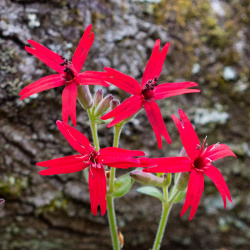 Out Of Stock
Fire Pink Seeds
Silene virginica
Best known for their fiery red blossoms, these rare flowers are stars of the show. This native perennial is fond of shady areas, but will also grow in sheltered areas with more sunshine.Quick View$3.96 Pkt - $320.00 / Oz
Out Of Stock
Fire Pink Seeds
Silene virginica
Best known for their fiery red blossoms, these rare flowers are stars of the show. This native perennial is fond of shady areas, but will also grow in sheltered areas with more sunshine.Quick View$3.96 Pkt - $320.00 / Oz -
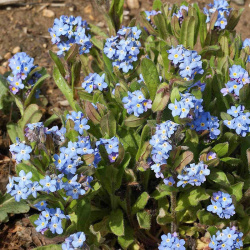 Forget Me Not Seeds
Myosotis sylvatica
One of the most beloved wildflowers, this true blue beauty captivates gardeners worldwide. Plant this annual en masse or as a border for an unforgettable spring bloom. Do not confuse this original wildflower with the Chinese Forget Me Not.Quick View$2.98 Pkt - $11.47 / Oz
Forget Me Not Seeds
Myosotis sylvatica
One of the most beloved wildflowers, this true blue beauty captivates gardeners worldwide. Plant this annual en masse or as a border for an unforgettable spring bloom. Do not confuse this original wildflower with the Chinese Forget Me Not.Quick View$2.98 Pkt - $11.47 / Oz -
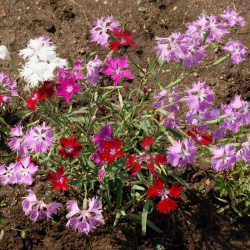 Fringed Pinks Seeds
Dianthus superbus
These lovely fringed pink flowers will fill the air with a heavenly scent. The exotic lacy blossoms range from pink to white and blooms in early spring of the second season. Very easy to grow, and very fancy to see.Quick View$2.98 Pkt - $12.65 / Oz
Fringed Pinks Seeds
Dianthus superbus
These lovely fringed pink flowers will fill the air with a heavenly scent. The exotic lacy blossoms range from pink to white and blooms in early spring of the second season. Very easy to grow, and very fancy to see.Quick View$2.98 Pkt - $12.65 / Oz -
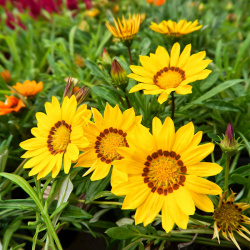 On Sale!
Gazania Seeds
Gazania splendens
These large, daisy-like flowers open with the sun and close with darkness. Coming from South Africa, they are naturally quite resistant to heat and drought. This multi-colored perennial makes an excellent addition to hillsides and wild areas in warmer climates, but can't handle the harsh winters of the north.Quick Viewx
On Sale!
Gazania Seeds
Gazania splendens
These large, daisy-like flowers open with the sun and close with darkness. Coming from South Africa, they are naturally quite resistant to heat and drought. This multi-colored perennial makes an excellent addition to hillsides and wild areas in warmer climates, but can't handle the harsh winters of the north.Quick ViewxGazania Seeds
Gazania splendens
These large, daisy-like flowers open with the sun and close with darkness. Coming from South Africa, they are naturally quite resistant to heat and drought. This multi-colored perennial makes an excellent addition to hillsides and wild areas in warmer climates, but can't handle the harsh winters of the north.
$3.96 Pkt - $26.00 / Oz -
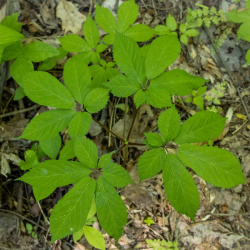 Out Of Stock
Ginseng Seeds
Panax quinquefolia
A famed medicinal herb in many cultures, these attractive perennials can live up to 100 years. In the wild, they prefer a woodland setting, so they are best grown in some shade. The white flower clusters produce red berries in the fall.Quick Viewx
Out Of Stock
Ginseng Seeds
Panax quinquefolia
A famed medicinal herb in many cultures, these attractive perennials can live up to 100 years. In the wild, they prefer a woodland setting, so they are best grown in some shade. The white flower clusters produce red berries in the fall.Quick ViewxGinseng Seeds
Panax quinquefolia
A famed medicinal herb in many cultures, these attractive perennials can live up to 100 years. In the wild, they prefer a woodland setting, so they are best grown in some shade. The white flower clusters produce red berries in the fall.
$3.96 Pkt - $136.00 / Oz -
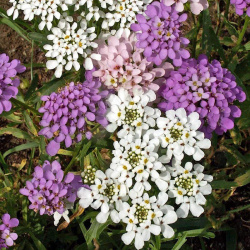 Globe Annual Candytuft Seeds
Iberis umbellata
This easy-to-grow favorite comes in lovely shades of pink, purple, and white. The fragrant perennial is perfect for a cottage garden or butterfly garden.Quick View$3.48 Pkt - $7.27 / Oz
Globe Annual Candytuft Seeds
Iberis umbellata
This easy-to-grow favorite comes in lovely shades of pink, purple, and white. The fragrant perennial is perfect for a cottage garden or butterfly garden.Quick View$3.48 Pkt - $7.27 / Oz -
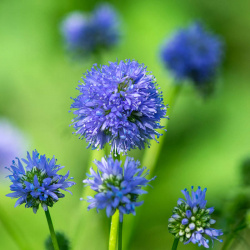 Globe Gilia Seeds
Gilia capitata
These pretty pincushion-like globes come in a lovely violet-blue hue. They are native to the West Coast but are grown as an annual in flower gardens across the US. The sweetly scented blossoms are also very attractive to butterflies.Quick View$2.98 Pkt - $7.65 / Oz
Globe Gilia Seeds
Gilia capitata
These pretty pincushion-like globes come in a lovely violet-blue hue. They are native to the West Coast but are grown as an annual in flower gardens across the US. The sweetly scented blossoms are also very attractive to butterflies.Quick View$2.98 Pkt - $7.65 / Oz











